#chasmosaurine
Explore tagged Tumblr posts
Text

Triceratops Sketch
#my art#dinosaurs#triceratops#trike#cera#herbivore#chasmosaurine ceratopsian#late cretaceous#paleo art#sketch#doodle#drawing
16 notes
·
View notes
Photo
I love how these are still very small triceratops. Like, adult Triceratops was stupidly huge compared to other ceratopsians. Three meters tall, and heavier than an elephant (that's three centrosaurs, four rhinos or six bulls).
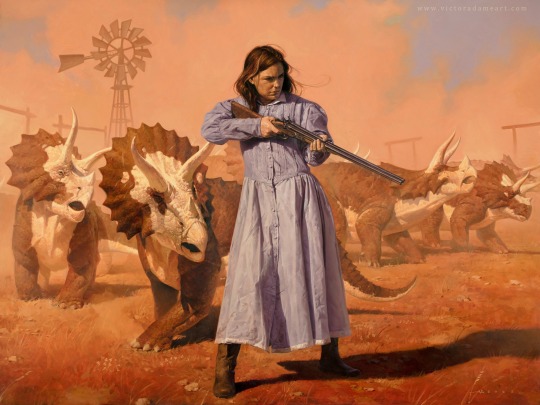
The Farmer’s Daughter by Victor Adame
50K notes
·
View notes
Text

Lokiceratops rangiformis was a ceratopsian dinosaur that lived during the Late Cretaceous (~78 million years ago) in what is now Montana, USA. Estimated at about 6.7m long (~22ft), it was one of the largest known members of the centrosaurine branch of the ceratopsians.
It had a unique arrangement of ornamentation on its skull, with no nose horn, two long brow horns, and a pair of huge asymmetrical curving blade-like spikes on the top of its square frill – some of the largest known frill spikes of any ceratopsian.
It lived in a swampy environment near the shore of the Western Interior Seaway, in an area that seems to have had an unusually high diversity of ceratopsians – along with Lokiceratops there were three other centrosaurines (Medusaceratops, Albertaceratops, and Wendiceratops), and one chasmosaurine (Judiceratops).
(There's also a possibility that it might not actually be a unique species. We know some other ceratopsians' faces changed quite drastically as they aged, so Lokiceratops could instead represent a fully mature individual of Medusaceratops.)
———
NixIllustration.com | Tumblr | Patreon
References:
Gramling, Carolyn. "Meet Lokiceratops, a newly discovered species of horned dinosaur." Science News, 20 June 2024, https://www.sciencenews.org/article/lokiceratops-new-species-horned-dinosaur
Loewen, Mark A., et al. "Lokiceratops rangiformis gen. et sp. nov.(Ceratopsidae: Centrosaurinae) from the Campanian Judith River Formation of Montana reveals rapid regional radiations and extreme endemism within centrosaurine dinosaurs." PeerJ 12 (2024): e17224. https://doi.org/10.7717/peerj.17224
Molinek, Rudy. “Dinosaur with Giant, Loki-like Horns Has the ‘craziest, Coolest’ Headgear-and Could Be a New Species.” Smithsonian Magazine, 20 June 2024, https://www.smithsonianmag.com/smart-news/dinosaur-with-giant-loki-like-horns-has-the-craziest-coolest-headgear-and-could-be-a-new-species-180984577/
Wikipedia contributors. “Lokiceratops.” Wikipedia, 1 Jul. 2024, https://en.wikipedia.org/wiki/Lokiceratops
#science illustration#paleontology#paleoart#palaeoblr#lokiceratops#centrosaurinae#ceratopsidae#ceratopsian#marginocephalia#ornithischia#dinosaur#art
359 notes
·
View notes
Text





Chasmosaurine Ceratopsians!
Torosaurus - Triceratops Chasmosaurus Pentaceratops - Arrhinoceratops
Stickers || Phone Wallpapers Masterlist
Planned or in the works: Achelousaurus
#art#my art#paleontology#paleoart#science#dinosaur#illustration#ceratopsian#torosaurus#triceratops#chasmosaurus#pentaceratops#arrhinoceratops
147 notes
·
View notes
Text
Archovember 2024 Day 9 - Spiclypeus shipporum

Spiclypeus shipporum was a large chasmosaurine ceratopsian from Late Cretaceous Montana, USA. It is only known from one specimen (a partial skull, vertebrae, ribs, a left humerus, a left ilium and the left hindlimb) nicknamed “Judith” after the Judith River Formation. But this specimen is very unique, with brow horns that swept out to the side and two epiparietals (frill horns) fused and curling down over its frill. Judith appeared to also have sustained an infection in their frill, hypothesised to have come from an injury inflicted by a rival Spiclypeus, where the rival’s brow horns pierced into the bone of Judith’s frill. They also had a more serious infection in their humerus, with a large abscess, as well as evidence of arthritis. Judith was an adult, at least 10 years old, and it’s suspected that they had reach an advanced age before dying, despite their injuries. They were a testament to the rough life of combat and survival ceratopsians faced, and their resilience in spite of it all.
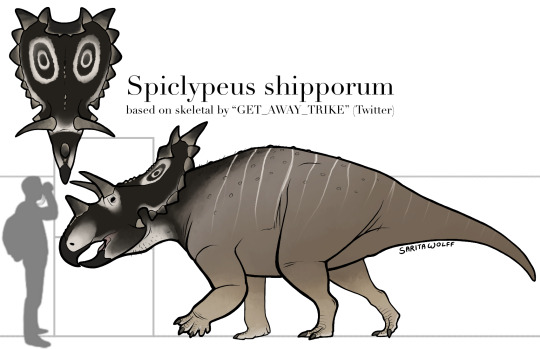
Spiclypeus lived in the Judith River Formation during the Late Campanian. It would have lived on a coastal floodplain criss-crossed by rivers and oxbow lakes. It may have lived alongside other ceratopsians, but there is a hypothesis that Spiclypeus, Ceratops montanus, and Pentaceratops aquilonius may all be the same species, however, so far their remains are too fragmentary to form a conclusion. It would have also shared space with the hadrosaur Corythosaurus, the ankylosaurs Edmontonia and Zuul, and the pachycephalosaur Hanssuesia. Theropods included the dromaeosaurs Dromaeosaurus and Saurornitholestes, the avialan Hesperornis altus, and the tyrannosaurid apex predators Daspletosaurus and Gorgosaurus. Other reptiles included lizards, turtles, the choristodere Champsosaurus, and the alligatoroids Leidyosuchus and Deinosuchus.

This art may be used for educational purposes, with credit, but please contact me first for permission before using my art. I would like to know where and how it is being used. If you don’t have something to add that was not already addressed in this caption, please do not repost this art. Thank you!
#Spiclypeus shipporum#Spiclypeus#ceratopsians#ornithischians#dinosaurs#archosaurs#archosauromorphs#reptiles#Archovember#archovember2024#Dinovember#Dinovember2024#DrawDinovember#DrawDinovember2024#SaritaDrawsPalaeo#Late Cretaceous#USA#Judith River Formation
64 notes
·
View notes
Text

A quick sketch-portrait I’ve made of Vagaceratops irvinensis, a chasmosaurine ceratopsian hailing from the Campanian Dinosaur Park Formation of Alberta, Canada.
#paleoart#dinosaur#dinosaurs#paleontology#paleoartist#paleoartwork#palaeontology#palaeoblr#palaeoart#sketches#traditional drawing#vagaceratops#ceratopsidae#ceratopsians#ceratopsian#dinosauria
51 notes
·
View notes
Text
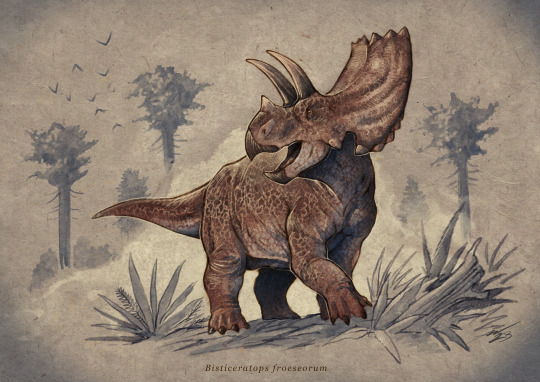
Day 14 - Bisticeratops, described in 2022 it’s a is a genus of chasmosaurine ceratopsians from the Late Cretaceous
#illustration#sketch#sketchbook#drawing#dinosaur#paleoart#dinosaurs#dinovember#dinovember2023#ceratopsian
171 notes
·
View notes
Text
Utahceratops
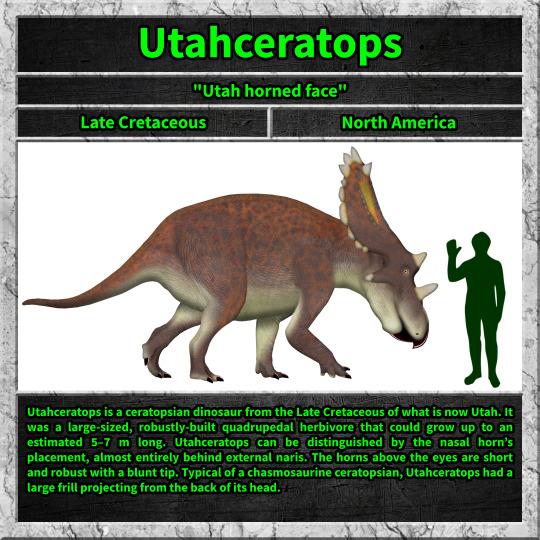
Utahceratops is a ceratopsian dinosaur from the Late Cretaceous of what is now Utah. It was a large-sized, robustly-built quadrupedal herbivore that could grow up to an estimated 5–7 m long. Utahceratops can be distinguished by the nasal horn’s placement, almost entirely behind external naris. The horns above the eyes are short and robust with a blunt tip. Typical of a chasmosaurine ceratopsian, Utahceratops had a large frill projecting from the back of its head.
59 notes
·
View notes
Text
Its moments like these that make me thrilled I'm a centrosaurine fan.

#dinosaurs#ooops blogging on my other interests#centrosaurine crew#I guess chasmosaurines are cool too#ceratopsian domination#spinosaurus#spinosaurus pain
13K notes
·
View notes
Text
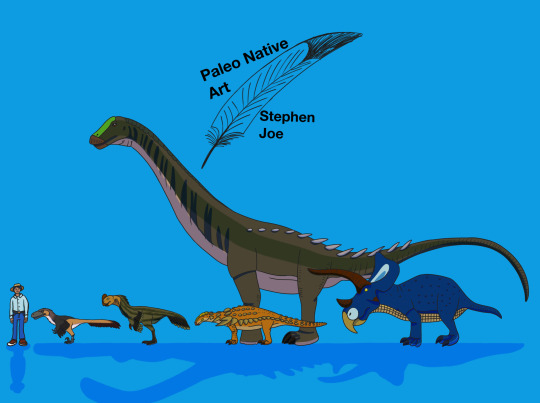
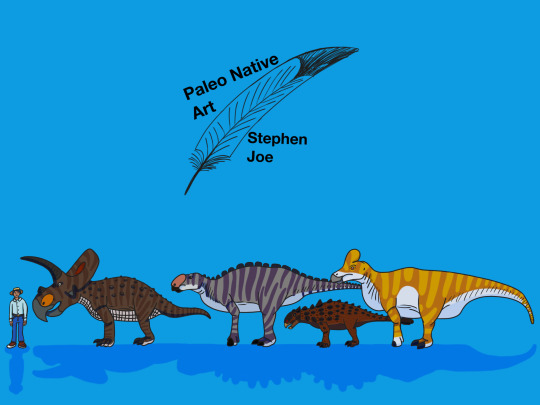

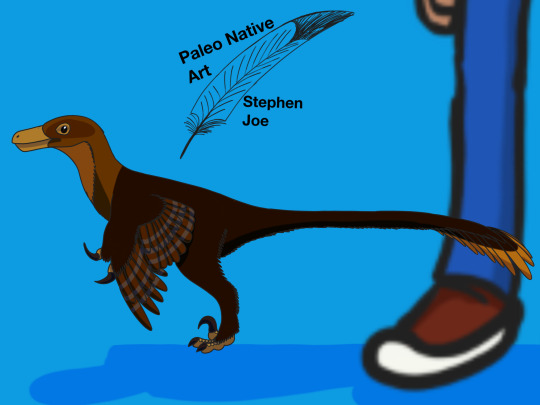
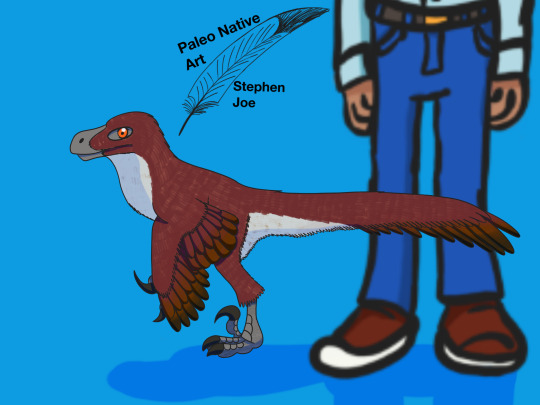
The Dinosaurs of the Ojo Alamo formation
Time for more to make a non-avian dinosaurs of the late Cretaceous period set in the heart of San Juan county, New Mexico. In fact, it’s very similar to northern laramidia such as Hell creek formation with subtropical warm and humid climate, and Lance formation with bayou environment. But unlike two other formations, Ojo Alamo formation has a lush floodplain dominated by wetlands and riparian forests. Home to the fossilized Cretaceous fishes, amphibians, turtles, squamates, crocodilians, and mammals.
As for the non-avian dinosaur species themselves, there were 5 species are officially valid (but one of them is possibly a nomen dubium). The rest however are indeterminate and unnamed species.
From left to right:
* Dineobellator notohesperus
* Ojoraptorsaurus boerei (nomen dubium as of 2025)
* Glyptodontopelta mimus
* Alamosaurus sanjuanensis
* Ojoceratops fowleri
As I said before, along with the other species of naashoibito member, they were unnamed or confer (Cf) other species of non-avian dinosaurs that were yet to describe.
From left to right (Herbivores side & Carnivores/Omnivores side)
* Ceratopsidae indet (An torosaurus-like chasmosaurine indet.)
* Hadrosauridae indet (Originally attended as Kritosaurus navajovius, but now its unknown species as “kritosaurini” indet.)
* Ankylosauridae indet (Noted as being similar to Ankylosaurus and Euoplocephalus.)
* Lambeosaurini indet (Noted as being similar to Corythosaurus and Hypacrosaurus.)
* Richardoestesia sp. (A few isolated teeth specimens.)
* Dromaeosauridae indet (An isolated teeth of the Saurornitholestinae indet similar to acheroraptor, but not as sharp as the latter.)
* Troodontidae indet (Isolated teeth specimens.)
* Ornithomimidae indet
* Tyrannosauridae indet (Formerly known as “Alamotyrannus brinkmanni.” Either Cf. Tyrannosaurus sp or possibly a new taxon species that is similar to Bistahieversor as closely related.)
For last but not surly least, it’s a same navajo man from my previous old art is back as sized scale for larger and smaller scale projects.
But the only these two are still there but ultimately not included were Caenagnathidae indet and Ankylosauria (possibly Nodosauridae) indet, due to both similarities of Ojoraptorsaurus and Glyptodontopelta which are distinct from other species.
Used skeletons of different species as references, belongs to Scott Hartman, Fadeno, GetAwayTrike, Jaime A. Headden, LancianIdolatry, Greg S. Paul, and Henry Sharpe Art.
#my art#myart#dinosaur#paleoart#my drawings#dinosaurs#dinosauria#ojo alamo formation#late cretaceous#theropod#sauropod#ornithischians#naayéé#navajo#sketchbook app#artists on tumblr#paleontology#fossil friday
12 notes
·
View notes
Text

“Within the fossil record, there are many species that were lost to the sands of time. Leaving nothing trace behind. Such bizzare creatures much like the Aye-ayes or the Sun bear. However, there are glimpses of this long gone time that show there oddity of the dinosaurs. One of these bizzare beasts was known as Tyranniventor cazaressei, or Cazares’ Hunter of tyrants.”
First discovered within a dig site in Arizona, this species of heavily derived member of the tyrannosaurine family. The theropod was estimated that this tyrannosaur to be around 2.3 meters at the hip and around 7 meters in length based on the original fossil that was discovered. It had strangely long arms and two brow horns that was similar to those seen in Carnotaurus or the Allosaurus of the Jurassic. It was estimated that this tyrannosaur lived during the late Cretaceous around 76-74.3 Mya and shared its ecosystem with hadrosaurines, fellow tyrannosaurs, chasmosaurines and possibly some abelisaurids that would’ve island hopped from Cretaceous South America.
What made this tyrannosaur unlike the other tyrannosaurs however, was the fact that the contents found within the original fossil specimen was the arm bone of a Teratophoneus, another fellow tyrannosaurid from the same time as Tyrannivenator. This “tyrant-eating” of the specimen had made it quite popular among the paleontological community with it further being boosted due to the tyrannosaur resembling a certain animated villain from a famous web video series called “spooky month”.
#my artwork#speculative biology#speculative evolution#fake dinosaurs#spooky month#paleontology#prehistoric#dinosaurs#tyrannosaurid#tyrannosauridae#bob velseb#spec bio#speculative prehistory
10 notes
·
View notes
Text

A relatively quick portrait of Tyrannosaurus mcraeensis from the Campanian-early Maastrichtian of the Hall Lake Formation in New Mexico. The dinosaur is described by partial jaw and skull fragments, as well as isolated teeth and chevrons. Initially, some of these bones were described as belonging to T. rex. T. mcraeensis, according to the team of paleontologists who described it, is characterized by a number of subtle differences from the type species in individual bones, including the shape of the postorbital protuberance, as well as teeth with thick tips, like those of the Asian Tarbosaurus. This dinosaur reached the same large size as the later T. rex. Its specific name refers to a sequence of rock layers called the "MacRae group" from which the bones were extracted. The animal belongs to a faunal complex that includes the large chasmosaurine Sierraceratops, the large hadrosaur and the titanosaur (probably Alamosaurus). The description of T. mcraeensis shows that North American tyrannosaurs became giants in the south of Laramidia, and then spread northward. It is worth noting that some paleontologists have been critical of the new taxon. For example, Thomas Carr points out that the differences are too small and one specimen is clearly not enough to distinguish the species. Anyway, I decided that the dinosaur deserves an image. Adobe Photoshop, 2024.
#tyrannosaurus mcraeensis#tyrannosaurus rex#tyrannosaurus#tyrannosauridae#theropod dinosaur#late cretaceous#paleoart
7 notes
·
View notes
Text

A rooted dinosaur tooth of a triceratopsin, a Triceratops sp. or Torosaurus latus from the Hell Creek Formation in Powder River County, Montana, United States. Teeth of these chasmosaurine ceratopsids are unfortunately indistinguishable. Derived ceratopsians are known for their double root while more early diverging species like Leptoceratops gracilis only have one; in this specimen, the second root had been broken off. There are currently 3 or 4 triceratopsins described, Triceratops horridus, Triceratops prorsus, Torosaurus latus, and the possibly dubious Tatankaceratops sacrisonorum.
#dinosaur#fossils#paleontology#palaeontology#paleo#palaeo#triceratops#torosaurus#tatankaceratops#ceratopsian#ceratopsidae#ornithischian#cretaceous#mesozoic#prehistoric#science#paleoblr#トリケラトプス#トロサウルス#タタンカケラトプス#ケラトプス科#角竜下目#恐竜#化石#古生物学
9 notes
·
View notes
Text
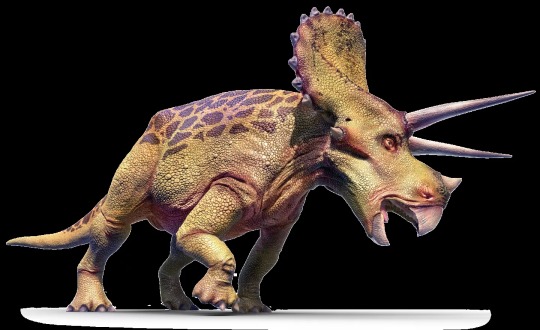

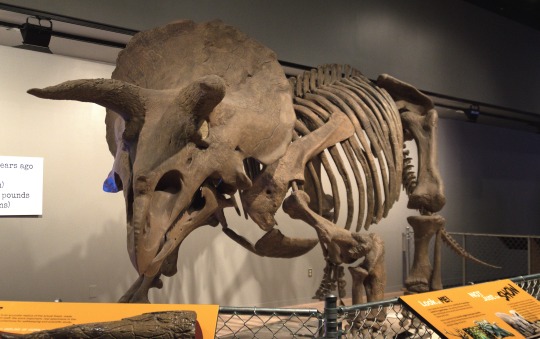
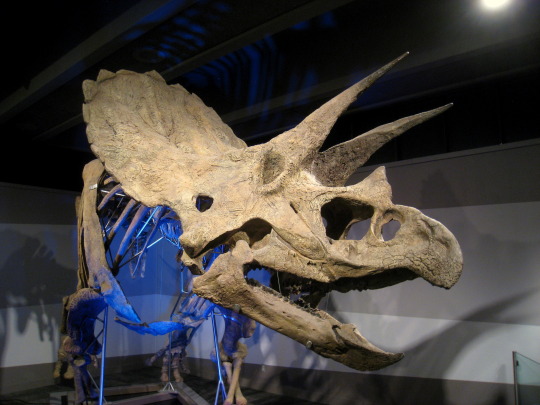

Triceratops
(temporal range: 68-66 mio. years ago)
[text from the Wikipedia article, see also link above]
Triceratops (/traɪˈsɛrətɒps/ try-SERR-ə-tops;[1] lit. 'three-horned face') is a genus of chasmosaurine ceratopsian dinosaur that lived during the late Maastrichtian age of the Late Cretaceous period, about 68 to 66 million years ago in what is now western North America. It was one of the last-known non-avian dinosaurs and lived until the Cretaceous–Paleogene extinction event 66 million years ago. The name Triceratops, which literally means 'three-horned face', is derived from the Greek words trí- (τρί-) meaning 'three', kéras (κέρας) meaning 'horn', and ṓps (ὤψ) meaning 'face'.
Bearing a large bony frill, three horns on the skull, and a large, four-legged body, exhibiting convergent evolution with bovines and rhinoceroses, Triceratops is one of the most recognizable of all dinosaurs and the most well-known ceratopsian. It was also one of the largest, up to 8–9 metres (26–30 ft) long and 5–9 metric tons (5.5–9.9 short tons) in body mass. It shared the landscape with and was most likely preyed upon by Tyrannosaurus, though it is less certain that two adults would battle in the fanciful manner often depicted in museum displays and popular media. The functions of the frills and three distinctive facial horns on its head have long inspired countless debates. Traditionally, these have been viewed as defensive weapons against predators. More recent interpretations find it probable that these features were primarily used in species identification, courtship, and dominance display, much like the antlers and horns of modern ungulates.
Triceratops was traditionally placed within the "short-frilled" ceratopsids, but modern cladistic studies show it to be a member of Chasmosaurinae, which usually have long frills. Two species, T. horridus and T. prorsus, are considered valid today. Seventeen different species, however, have been named throughout history. Research published in 2010 concluded that the contemporaneous Torosaurus, a ceratopsid long regarded as a separate genus, represents Triceratops in its mature form. This view has still been highly disputed and much more data is needed to settle this ongoing debate.
Triceratops has been documented by numerous remains collected since the genus was first described in 1889 by American paleontologist Othniel Charles Marsh. Specimens representing life stages from hatchling to adult have been found. As the archetypal ceratopsian, Triceratops is one of the most beloved, popular dinosaurs and has been featured in numerous films, postage stamps, and many other types of media.
4 notes
·
View notes
Text
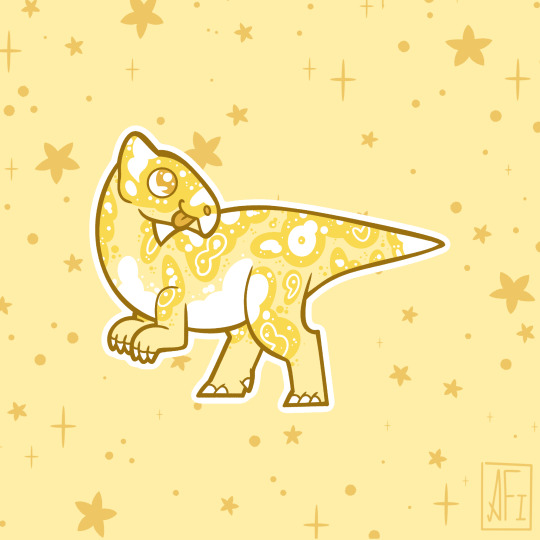
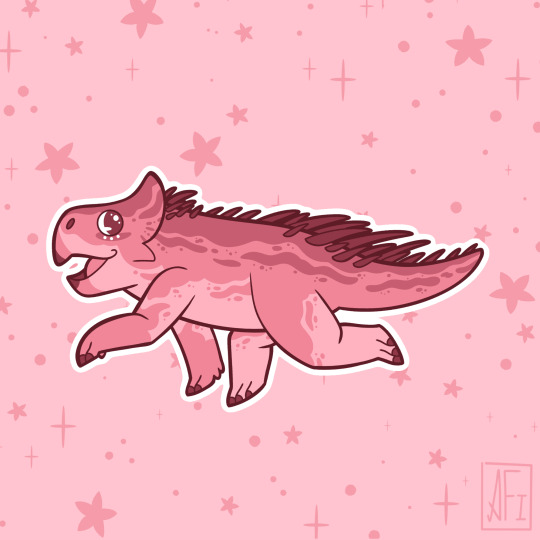
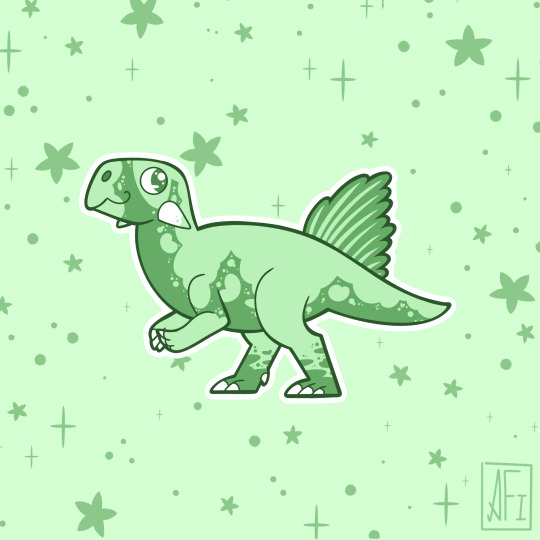
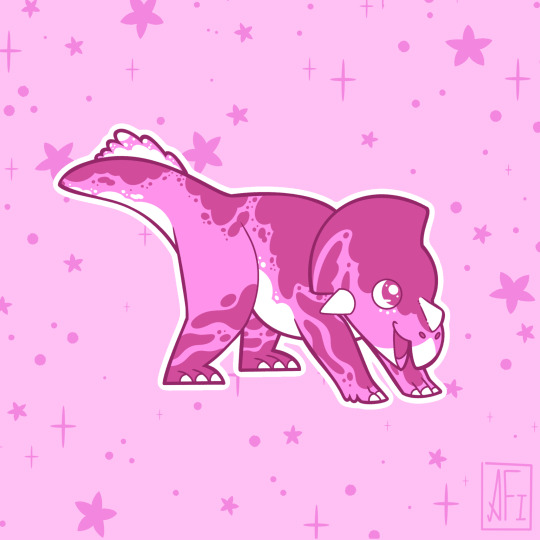
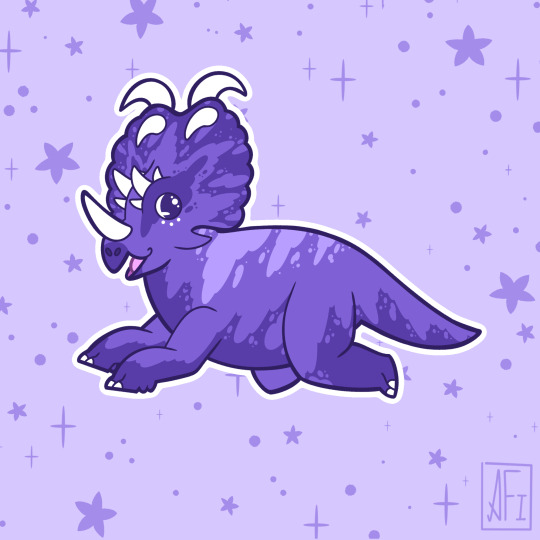
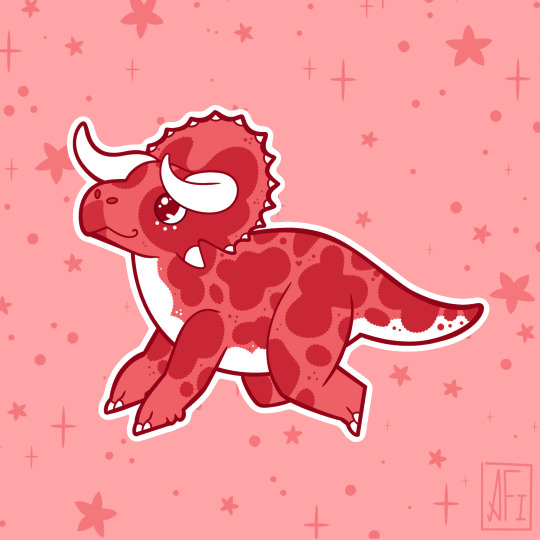


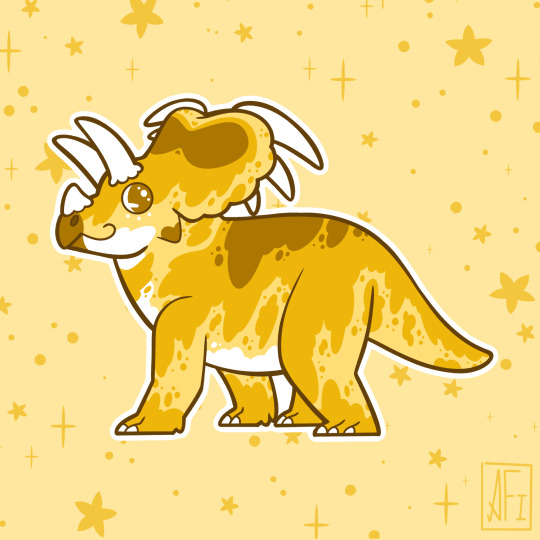

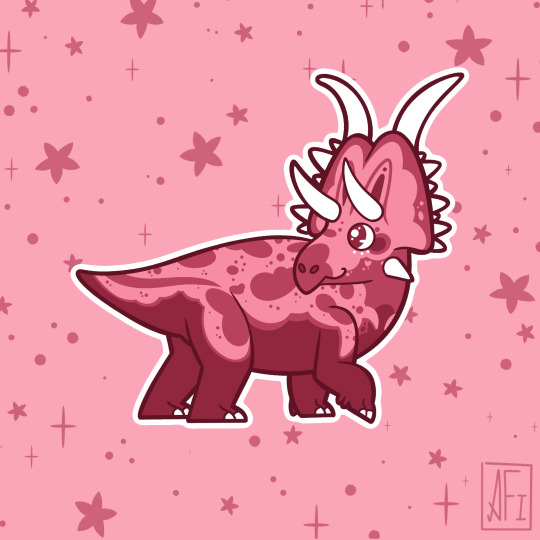
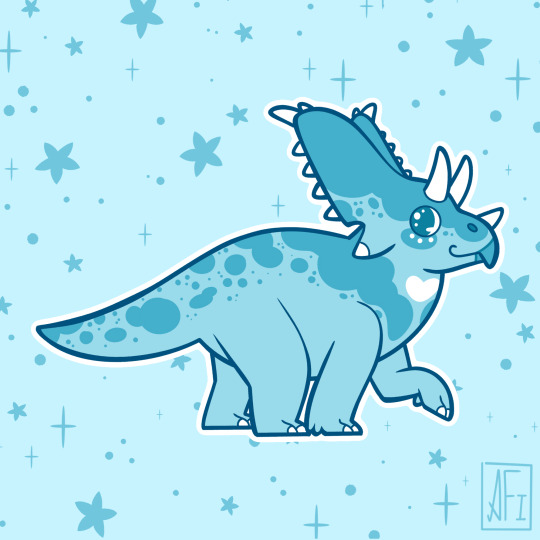
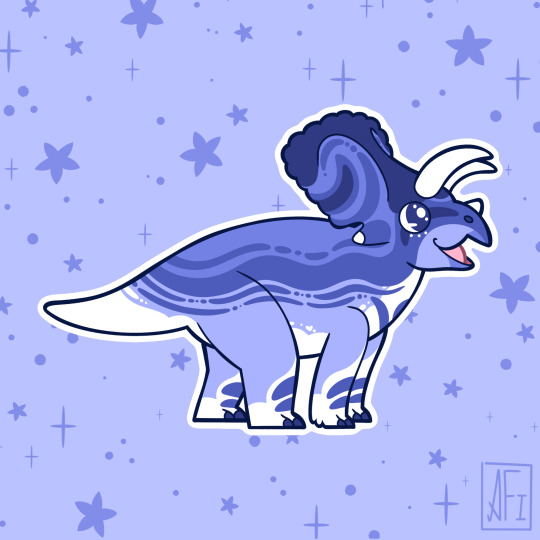
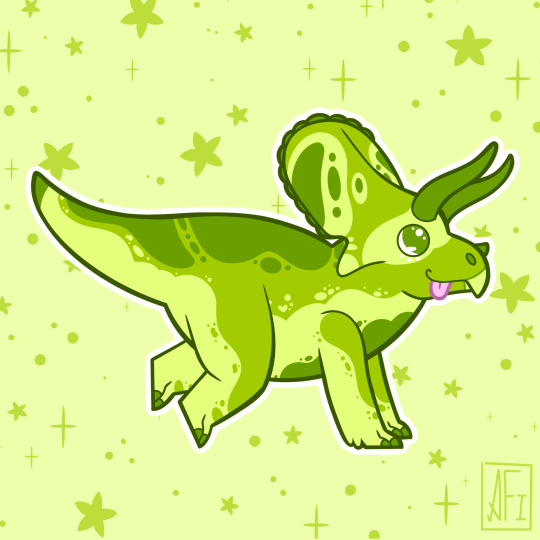
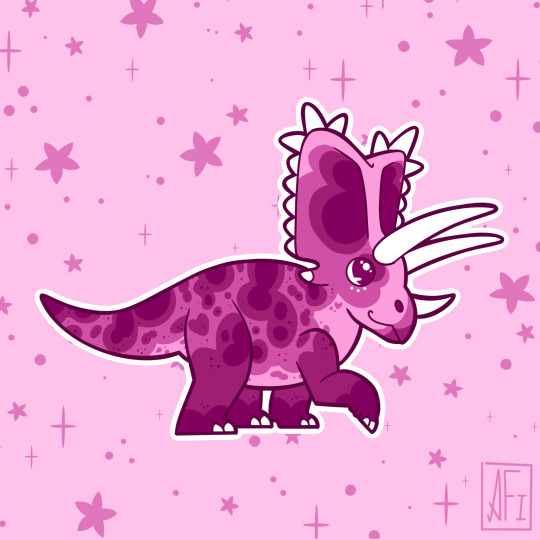
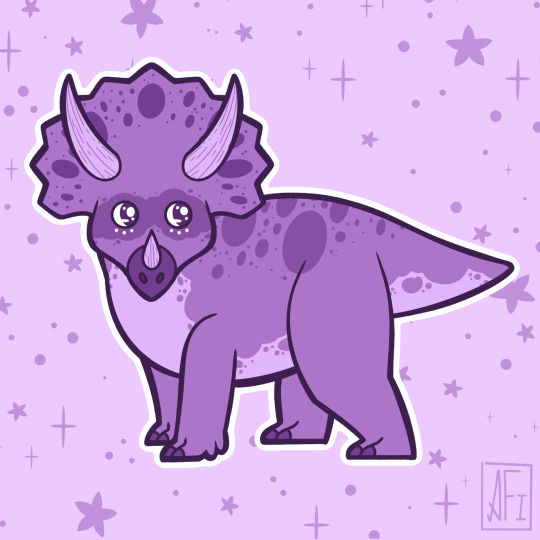
All of my Ceratopsians! I've got them somewhat grouped by types, though I definitely need more early Ceratopsians or miscellaneous ones outside the family Ceratopsidae.
Yinlong - Gryphoceratops - Psittacosaurus
Protoceratops - Centrosaurus - Nasutoceratops
Styracosaurus - Sinoceratops - Medusaceratops
Pachyrhinosaurus - Diabloceratops - Chasmosaurus
Arrhinoceratops - Torosaurus - Pentaceratops
Triceratops
Italic: Outside the family Ceratopsidae. Bold: Centrosaurine Ceratopsians Underlined: Chasmosaurine Ceratopsians
Ceratopsians Pack || Stickers || Phone Wallpapers Masterlist
Planned or in the works: Kosmoceratops, Lokiceratops, Albertaceratops, Aquilops, Spinops, Achelousaurus, Einiosaurus, Zuniceratops, Beg, Wendiceratops, Micropachycephalosaurus (??), Stenopelix (??)
#art#my art#paleoart#paleontology#science#illustration#dinosaur#ceratopsian#triceratops#pachyrhinosaurus#chasmosaurus#pentaceratops#protoceratops#psittacosaurus#styracosaurus
49 notes
·
View notes
Text
My lady in Christ it’s just a Megaraptorid, Chasmosaurine and a Macronaria like dinosaurs that are based on the legendary beasts.



I mean, they’re among the best of the paradox designs BY FAR, and they fit the theming of paradoxes, well, paradoxes! And honestly, if they WERE from the past, I’d could STILL make sense because of them being inspired by them by ho-oh! For an example: Here
As for the “fan service” MY LADY CHARIZARD GOT THREE GODDAMM FORMS and your mad that there are some dinosaur beasts and they get some actually good forms.
HELL the region might as well be called “the Johto redemption” because it gave new forms and evolutions to MANY pokemon who deserved more attention!






i need to speak my truth
#pokemon#No paradox beast slander on MY WATCH.#rants#pokemon scarlet#pokemon scarlet and violet#walking wake#raging bolt#gouging fire#We love the Dino legendary beasts in this house
111 notes
·
View notes